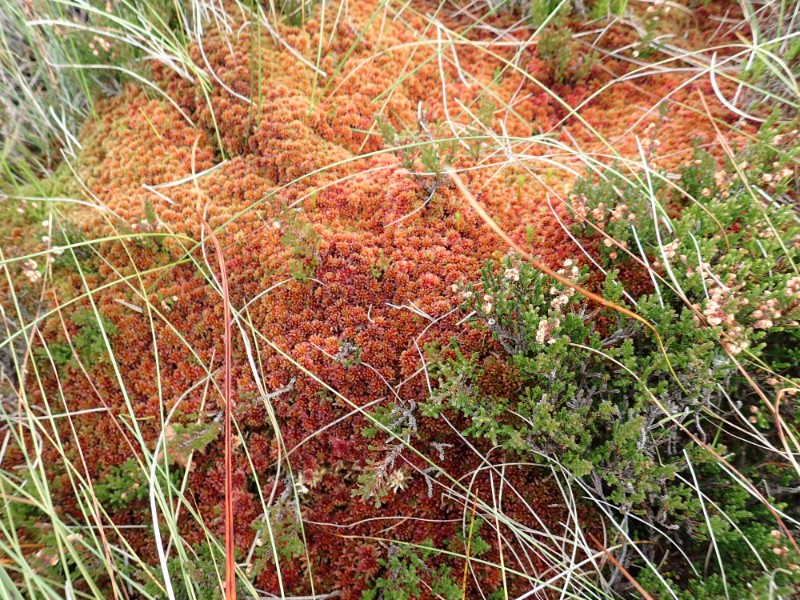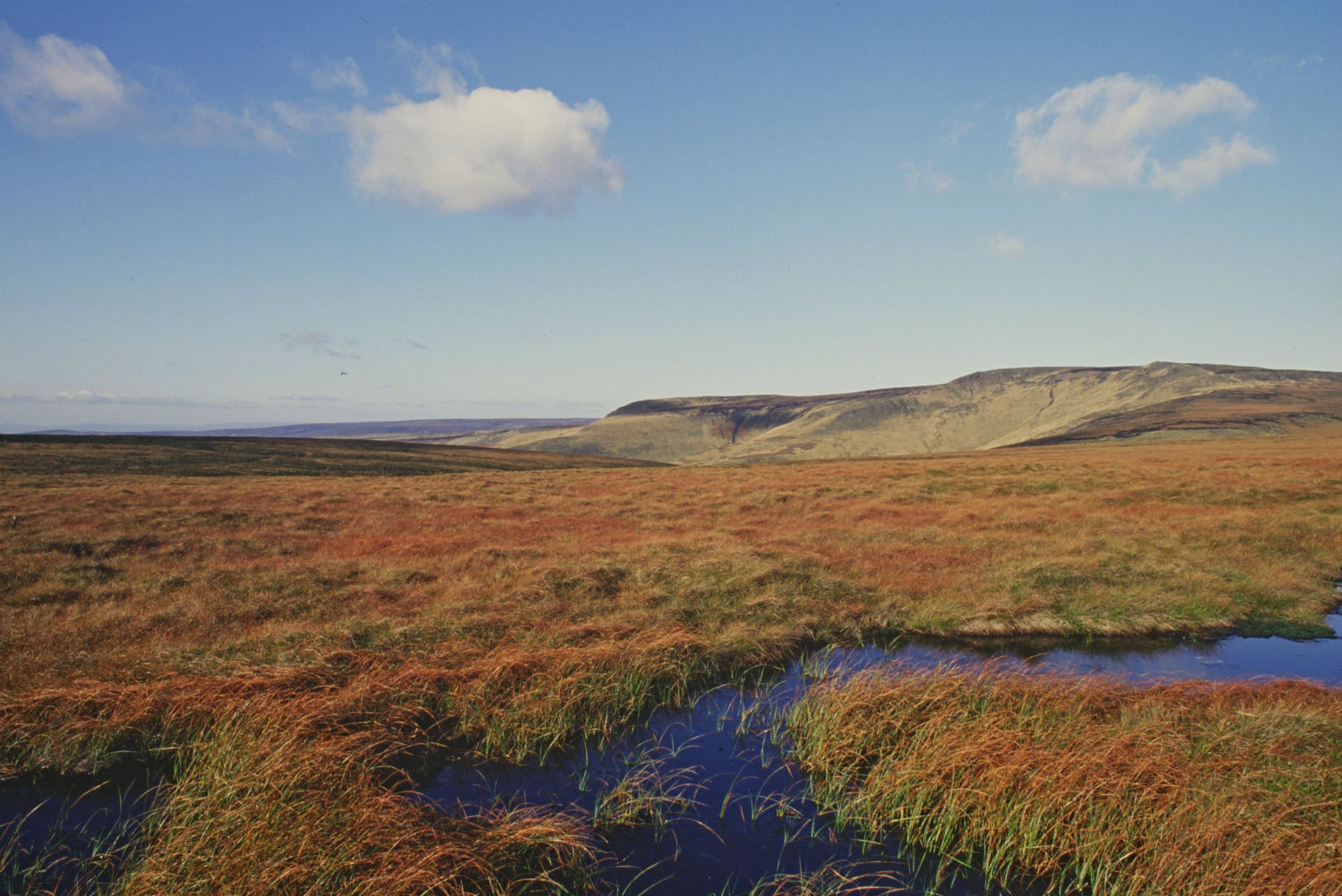Moors for the Future Partnership
The Partnership has brought about the restoration of landscape laid waste by 150 years of industrial pollution and over 400 wildfires. It has raised £50 million and delivered restoration work to 35 square kilometres of degraded blanket bog with a large programme of associated engagement and science work - delivering critical evidence and a change in behaviour.
- We have developed techniques for stabilising peat which have resulted in the successful re-vegetation of bare peat
- In the first 20 years we have transformed over 35 sq km of bare peat
See a map of the Partnership's work
Moors for the Future Partnership's working area
- The Partnership works across the South Pennine Moors Special Area of Conservation and the West Pennine Moors Site of Special Scientific Interest (SSSI)
- This area has been described as the most damaged upland landscape in Europe (750 sq km of “rarer than rainforest” blanket bog, most of it in unfavourable but recovering condition)
- 11.5 million people live in the regions around this area, all of them relying on this landscape for drinking water and many of them live in communities at risk of flooding
- It is a location and landscape at the very front line of climate change which is on the cusp of being made adaptive and robust to this challenge
The Peak District and South Pennines
- There are high levels of heavy metals in peat in the Peak District and South Pennines because they were present in smoke from factories during the industrial revolution
- Heavy metals found in the peat soil include copper, zinc, cadmium and lead
- These metals are so abundant that metal eating bacteria normally found on scrapheaps have been found in the peat
- Levels of zinc and copper in waterways coming off the moors are beyond EU thresholds
- Water companies in the area have to dispose of sediment in their reservoirs as toxic waste when dredged because of the abundance of heavy metals
- Acid rain has turned peat, in some cases, to the same pH as lemon juice. This has decimated sphagnum moss populations and made the environment inhospitable for plants to grow
- Worst eroding square kilometres of moorland are losing 800 tonnes carbon per year
- These areas could be sequestering (taking in and storing) up to 500 tonnes carbon per year
Blanket bog
Carbon:
- English peatlands store the equivalent of 580 million tonnes of carbon (source: Natural England)
- English peatlands emit 11 million tonnes per year (source: Natural England)
- Over 40 million tonnes of carbon stored in South Pennines SAC and West Pennine Moors.
- Formed over millennia – some blanket bogs are 9,000 years old.
- Sphagnum moss is essential to forming peat, which accumulates at about 1mm per year.
Sphagnum - marvellous moss
- Sphagnum moss is a key component of blanket bogs
- Sphagnum can hold up to 20 times its weight in water
- 30% reductions in peak discharge of large storms* * Source Pilkington et all (2015). Restoration of Blanket bogs; flood risk reduction and other ecosystem benefits
- Holds back water - increasing lag times by around 20 minutes
- Each kind of sphagnum moss has its own shade of colour, ranging from red, pink and orange through to green
- Some grow underwater in pools and wet hollows whilst others can survive in fairly dry conditions
- Hummocks are created by sphagnum mosses growing to form large mounds up to a metre high
- Some mosses grow only a few millimetres a year, while others grow over 3cm
- Mosses grow from spores which are produced in fruiting bodies called capsules
- Sphagnum mosses produce chemicals which increase the acidity of the water and further prevent the decay of dead plants
- Dry sphagnum moss is absorbent and also mildly antiseptic.
- During the First and Second World Wars it was used as wound dressings. It was also used for lamp wicks, bedding and babies’ nappies
- Sphagnum moss is now used by gardeners for a variety of purposes
The cost of restoration
- Cost of repairing blanket bog up to £36,000 per hectare (Source - MFFP Restoration Costs)
- 1 hectare of restored blanket bog avoids19 tonnes of carbon loss per year (Source: Defra)
British Bogs
- There are three main types of peatlands in the UK: blanket bog, raised bog and fenland.
- The UK has 13% of all the world’s blanket bog
- 60% of the UK’s peatland is in Scotland
- Peatlands are home to rare wading birds such as dunlin, the threatened hen harrier, weird and wonderful plants like the insect-eating sundew and throngs of insects including dragonflies, large heath butterflies, emperor moths and dazzling jewel beetles
The benefits of bogs
- Peatland vegetation slows the flow of rainfall, helping to prevent flooding in local towns and villages
- UK’s Peatlands store over three billion tonnes of carbon, around the same amount as all the forest in the UK, France and Germany put together
- Peat is the single biggest store of carbon in the UK, storing the equivalent of 20 years of all UK CO2 emissions and keeping it out of the atmosphere.
- Inland water bodies including peatlands provide £1.5 billion value in terms of water quality
- 70% of UK drinking water comes from upland areas dominated by peatlands
- Peatlands are home to rare wading birds such as dunlin, the threatened hen harrier, weird and wonderful plants like the insect-eating sundew and throngs of insects including dragonflies, large heath butterflies, emperor moths and dazzling jewel beetles
Damaged Peatlands
- Poor drinking water quality
- Source of carbon emissions
- Large contribution to failing waterbody condition
- Large contribution to failing SSSI condition
- Rapid reaction to heavy rain
- Poor resilience to fires
- Poor resilience to drought

Blanket bog formation
Dead remains of the sphagnum mosses pile up and get pressed together to eventually form the soil we know as peat. Peat forms at a very slow rate – 1mm per year or 1 metre per millennium.
